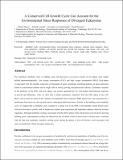| dc.contributor.author | Slavov, Nikolai | |
| dc.contributor.author | Airoldi, Edoardo Maria | |
| dc.contributor.author | van Oudenaarden, A. | |
| dc.contributor.author | Botstein, D. | |
| dc.date.accessioned | 2014-07-22T17:42:58Z | |
| dc.date.issued | 2012 | |
| dc.identifier.citation | Slavov, N., E. M. Airoldi, A. van Oudenaarden, and D. Botstein. 2012. “A Conserved Cell Growth Cycle Can Account for the Environmental Stress Responses of Divergent Eukaryotes.” Molecular Biology of the Cell 23, no. 10: 1986–1997. | en_US |
| dc.identifier.issn | 1059-1524 | en_US |
| dc.identifier.uri | http://nrs.harvard.edu/urn-3:HUL.InstRepos:12553736 | |
| dc.description.abstract | The respiratory metabolic cycle in budding yeast (Saccharomyces cerevisiae) consists of two phases most simply defined phenomenologically: low oxygen consumption (LOC) and high oxygen consumption (HOC). Each phase is associated with the periodic expression of thousands of genes, producing oscillating patterns of gene-expression found in synchronized cultures and in single cells of slowly growing unsynchronized cultures. Systematic variation in the durations of the HOC and LOC phases can account quantitatively for well-studied transcriptional responses to growth rate differences. Here we show that a similar mechanism, transitions from the HOC phase to the LOC phase, can account for much of the common environmental stress response (ESR) and for the cross protection by a preliminary heat stress (or slow growth rate) to subsequent lethal heat-stress. Similar to the budding yeast metabolic cycle, we suggest that a metabolic cycle, coupled in a similar way to the ESR, in the distantly related fission yeast, Schizosaccharomyces pombe, and in human can explain gene-expression and respiratory patterns observed in these organisms. Although metabolic cycling is associated with the G0/G1 phase of the cell division cycle of slowly growing budding yeast, transcriptional cycling was detected in the G2 phase of the division cycle in fission yeast, consistent with the idea that respiratory metabolic cycling occurs during the phases of the cell division cycle associated with mass accumulation in these divergent eukaryotes. | en_US |
| dc.description.sponsorship | Statistics | en_US |
| dc.language.iso | en_US | en_US |
| dc.publisher | American Society for Cell Biology (ASCB) | en_US |
| dc.relation.isversionof | doi:10.1091/mbc.e11-11-0961 | en_US |
| dash.license | OAP | |
| dc.subject | metabolic cycle; environmental stress; environmental stress response; common stress response; stress; cross protection; viability; cell growth; growth rate; growth rate response; heat shock; cell cycle; cell division cycle; Warburg effect; Warburg; glucose wasting; cancer; single cells; budding yeast; fission yeast; human | en_US |
| dc.title | A conserved cell growth cycle can account for the environmental stress responses of divergent eukaryotes | en_US |
| dc.type | Journal Article | en_US |
| dc.description.version | Accepted Manuscript | en_US |
| dc.relation.journal | Molecular Biology of the Cell | en_US |
| dash.depositing.author | Airoldi, Edoardo Maria | |
| dc.date.available | 2014-07-22T17:42:58Z | |
| dc.identifier.doi | 10.1091/mbc.e11-11-0961 | * |
| dash.contributor.affiliated | Slavov, Nikolai | |
| dash.contributor.affiliated | Airoldi, Edoardo | |


